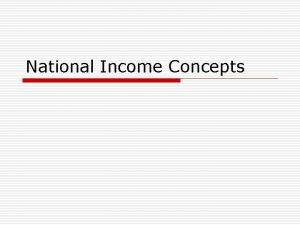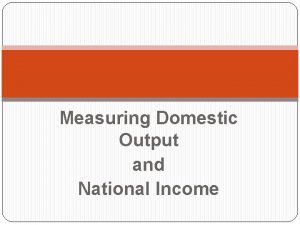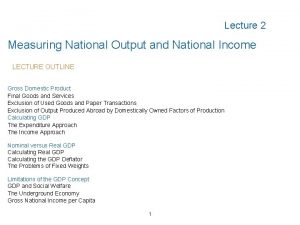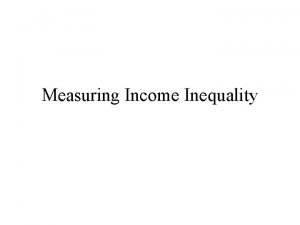CHAPTER 6 Measuring National Output and National Income






































- Slides: 38

CHAPTER 6 Measuring National Output and National Income Prepared by: Fernando Quijano and Yvonn Quijano © 2004 Prentice Hall Business Publishing Principles of Economics, 7/e Karl Case, Ray Fair

C H A P T E R 6: Measuring National Output and National Income Gross Domestic Product • Gross domestic product (GDP) is the total market value of all final goods and services produced within a given period by factors of production located within a country. © 2004 Prentice Hall Business Publishing Principles of Economics, 7/e Karl Case, Ray Fair 2

C H A P T E R 6: Measuring National Output and National Income and Product Accounts • National income and product accounts are data collected and published by the government describing the various components of national income and output in the economy. • The U. S. Department of Commerce is responsible for producing and maintaining the “National Income and Product Accounts” that keep track of GDP. © 2004 Prentice Hall Business Publishing Principles of Economics, 7/e Karl Case, Ray Fair 3

C H A P T E R 6: Measuring National Output and National Income Final Goods and Services • The term final goods and services in GDP refers to goods and services produced for final use. • Intermediate goods are goods produced by one firm for use in further processing by another firm. © 2004 Prentice Hall Business Publishing Principles of Economics, 7/e Karl Case, Ray Fair 4

C H A P T E R 6: Measuring National Output and National Income Value Added • Value added is the difference between the value of goods as they leave a stage of production and the cost of the goods as they entered that stage. • In calculating GDP, we can either sum up the value added at each stage of production, or we can take the value of final sales. © 2004 Prentice Hall Business Publishing Principles of Economics, 7/e Karl Case, Ray Fair 5

C H A P T E R 6: Measuring National Output and National Income Value Added in the Production of a Gallon of Gasoline (Hypothetical Numbers) STAGE OF PRODUCTION VALUE OF SALES VALUE ADDED $. 50 (2) Refining . 65 . 15 (3) Shipping . 80 . 15 1. 00 . 20 (1) Oil drilling (4) Retail sale Total value added © 2004 Prentice Hall Business Publishing $1. 00 Principles of Economics, 7/e Karl Case, Ray Fair 6

C H A P T E R 6: Measuring National Output and National Income Exclusions of Used Goods and Paper Transactions • GDP ignores all transactions in which money or goods change hands but in which no new goods and services are produced. © 2004 Prentice Hall Business Publishing Principles of Economics, 7/e Karl Case, Ray Fair 7

C H A P T E R 6: Measuring National Output and National Income Exclusion of Output Produced Abroad by Domestically Owned Factors of Production • GDP is the value of output produced by factors of production located within a country. Output produced by a country’s citizens, regardless of where the output is produced, is measured by gross national product (GNP). © 2004 Prentice Hall Business Publishing Principles of Economics, 7/e Karl Case, Ray Fair 8

C H A P T E R 6: Measuring National Output and National Income Calculating GDP can be computed in two ways: • The expenditure approach: A method of computing GDP that measures the total amount spent on all final goods during a given period. • The income approach: A method of computing GDP that measures the income —wages, rents, interest, and profits— received by all factors of production in producing final goods. © 2004 Prentice Hall Business Publishing Principles of Economics, 7/e Karl Case, Ray Fair 9

C H A P T E R 6: Measuring National Output and National Income The Expenditure Approach Expenditure categories: • Personal consumption expenditures (C)—household spending on consumer goods. • Gross private domestic investment (I)—spending by firms and households on new capital: plant, equipment, inventory, and new residential structures. © 2004 Prentice Hall Business Publishing Principles of Economics, 7/e Karl Case, Ray Fair 10

C H A P T E R 6: Measuring National Output and National Income The Expenditure Approach Expenditure categories: • Government consumption and gross investment (G) • Net exports (EX – IM)—net spending by the rest of the world, or exports (EX) minus imports (IM) © 2004 Prentice Hall Business Publishing Principles of Economics, 7/e Karl Case, Ray Fair 11

C H A P T E R 6: Measuring National Output and National Income The Expenditure Approach • The expenditure approach calculates GDP by adding together the four components of spending. In equation form: © 2004 Prentice Hall Business Publishing Principles of Economics, 7/e Karl Case, Ray Fair 12

C H A P T E R 6: Measuring National Output and National Income Components of GDP, 1999: The Expenditure Approach Components of GDP, 2002: The Expenditure Approach Personal consumption expenditures (C) Durable goods Nondurable goods Services Gross private domestic investment (l) Nonresidential Residential Change in business inventories Government consumption and gross investment (G) Federal State and local Net exports (EX – IM) Exports (EX) Imports (IM) Total gross domestic product (GDP) BILLIONS OF DOLLARS PERCENTAGE OF GDP 7303. 7 871. 9 2115. 0 4316. 8 1543. 2 1117. 4 471. 9 3. 9 1972. 9 693. 7 1279. 2 - 423. 6 1014. 9 1438. 5 10446. 2 69. 9 8. 3 20. 2 41. 3 14. 8 10. 7 4. 5 0 18. 9 6. 6 12. 2 - 4. 1 9. 8 13. 8 100. 0 Note: Numbers may not add exactly because of rounding. Source: U. S. Department of Commerce, Bureau of Economic Analysis. © 2004 Prentice Hall Business Publishing Principles of Economics, 7/e Karl Case, Ray Fair 13

C H A P T E R 6: Measuring National Output and National Income Personal Consumption Expenditures • Personal consumption expenditures (C) are expenditures by consumers on the following: • Durable goods: Goods that last a relatively long time, such as cars and appliances. • Nondurable goods: Goods that are used up fairly quickly, such as food and clothing. • Services: Things that do not involve the production of physical things, such as legal services, medical services, and education. © 2004 Prentice Hall Business Publishing Principles of Economics, 7/e Karl Case, Ray Fair 14

C H A P T E R 6: Measuring National Output and National Income Gross Private Domestic Investment • Investment refers to the purchase of new capital. • Total investment by the private sector is called gross private domestic investment. It includes the purchase of new housing, plants, equipment, and inventory by the private sector. © 2004 Prentice Hall Business Publishing Principles of Economics, 7/e Karl Case, Ray Fair 15

C H A P T E R 6: Measuring National Output and National Income Gross Private Domestic Investment • Nonresidential investment includes expenditures by firms for machines, tools, plants, and so on. • Residential investment includes expenditures by households and firms on new houses and apartment buildings. • Change in inventories computes the amount by which firms’ inventories change during a given period. Inventories are the goods that firms produce now but intend to sell later. © 2004 Prentice Hall Business Publishing Principles of Economics, 7/e Karl Case, Ray Fair 16

C H A P T E R 6: Measuring National Output and National Income Gross Private Domestic Investment • Remember that GDP is not the market value of total sales during a period—it is the market value of total production. • The relationship between total production and total sales is: GDP = final sales + change in business inventories © 2004 Prentice Hall Business Publishing Principles of Economics, 7/e Karl Case, Ray Fair 17

C H A P T E R 6: Measuring National Output and National Income Gross Investment versus Net Investment • Gross investment is the total value of all newly produced capital goods (plant, equipment, housing, and inventory) produced in a given period. • Depreciation is the amount by which an asset’s value falls in a given period. • Net investment equals gross investment minus depreciation. capitalend of period = capitalbeginning of period + net investment © 2004 Prentice Hall Business Publishing Principles of Economics, 7/e Karl Case, Ray Fair 18

C H A P T E R 6: Measuring National Output and National Income Government Consumption and Gross Investment • Government consumption and gross investment (G) counts expenditures by federal, state, and local governments for final goods and services. © 2004 Prentice Hall Business Publishing Principles of Economics, 7/e Karl Case, Ray Fair 19

C H A P T E R 6: Measuring National Output and National Income Net Exports • Net exports (EX – IM) is the difference between exports and imports. The figure can be positive or negative. • Exports (EX) are sales to foreigners of U. S. -produced goods and services. • Imports (IM) are U. S. purchases of goods and services from abroad). © 2004 Prentice Hall Business Publishing Principles of Economics, 7/e Karl Case, Ray Fair 20

C H A P T E R 6: Measuring National Output and National Income The Income Approach • National income is the total income earned by the factors of production owned by a country’s citizens. • The income approach to GDP breaks down GDP into four components: GDP = national income + depreciation + (indirect taxes – subsidies) + net factor payments to the rest of the world + other © 2004 Prentice Hall Business Publishing Principles of Economics, 7/e Karl Case, Ray Fair 21

C H A P T E R 6: Measuring National Output and National Income The Income Approach Components of GDP, 2002: The Income Approach BILLIONS OF DOLLARS PERCENTAGE OF GDP 8, 199. 9 80. 3 6, 010. 0 58. 9 Proprietors’ income 943. 5 7. 3 Corporate profits 748. 9 7. 3 Net interest 554. 8 5. 4 Rental income 142. 7 1. 4 National income Compensation of employees Depreciation Indirect taxes minus subsidies Net factor payments to the rest of the world Other Gross domestic product 1, 351. 3 739. 4 11. 1 - 96. 1 10, 205. 6 13. 2 7. 2 0. 1 - 0. 9 100. 0 Source: See Table 18. 2. © 2004 Prentice Hall Business Publishing Principles of Economics, 7/e Karl Case, Ray Fair 22

C H A P T E R 6: Measuring National Output and National Income From GDP to Disposable Personal Income GDP, GNP, National Income, Personal Income, and Disposable Personal Income, 2002 GDP Plus: receipts of factor income from the rest of the world Less: payments of factor income to the rest of the world Equals: GNP Less: depreciation Equals: net national product (NNP) Less: indirect taxes minus subsidies plus other Equals: national income Less: Plus: corporate profits minus dividends social insurance payments personal interest income received from the government and consumers transfer payments to persons Equals: personal income Less: personal taxes Equals: disposable personal income DOLLARS (BILLIONS) 10, 205. 6 + 342. 1 - 353. 2 10, 194. 5 - 1, 351. 3 8, 843. 2 - 643. 3 8, 199. 9 - 332. 6 - 731. 2 + 439. 1 +1, 148. 7 8, 723. 9 - 1, 306. 2 7, 417. 7 Source: See Table 18. 2. © 2004 Prentice Hall Business Publishing Principles of Economics, 7/e Karl Case, Ray Fair 23

C H A P T E R 6: Measuring National Output and National Income From GDP to Disposable Personal Income • Net national product equals gross national product minus depreciation; a nation’s total product minus what is required to maintain the value of its capital stock. • Personal income is the income received by households after paying social insurance taxes but before paying personal income taxes. © 2004 Prentice Hall Business Publishing Principles of Economics, 7/e Karl Case, Ray Fair 24

C H A P T E R 6: Measuring National Output and National Income Disposable Personal Income and Personal Saving, 2002 DOLLARS (BILLIONS) Disposable personal income Less: Personal consumption expenditures Interest paid by consumers to business Personal transfer payments to foreigners Equals: personal saving Personal savings as a percentage of disposable personal income: 7, 417. 7 - 7063. 5 - 204. 3 - 31. 3 118. 6 1. 6% Source: See Table 18. 2. © 2004 Prentice Hall Business Publishing Principles of Economics, 7/e Karl Case, Ray Fair 25

C H A P T E R 6: Measuring National Output and National Income Disposable Personal Income and Personal Saving • The personal saving rate is the percentage of disposable personal income that is saved. • If the personal saving rate is low, households are spending a large amount relative to their incomes; if it is high, households are spending cautiously. © 2004 Prentice Hall Business Publishing Principles of Economics, 7/e Karl Case, Ray Fair 26

C H A P T E R 6: Measuring National Output and National Income Nominal Versus Real GDP • Nominal GDP is GDP measured in current dollars, or the current prices we pay for things. Nominal GDP includes all the components of GDP valued at their current prices. • When a variable is measured in current dollars, it is described in nominal terms. © 2004 Prentice Hall Business Publishing Principles of Economics, 7/e Karl Case, Ray Fair 27

C H A P T E R 6: Measuring National Output and National Income Calculating Real GDP • A weight is the importance attached to an item within a group of items. • A base year is the year chosen for the weights in a fixed-weight procedure. • A fixed-weight procedure uses weights from a given base year. © 2004 Prentice Hall Business Publishing Principles of Economics, 7/e Karl Case, Ray Fair 28

C H A P T E R 6: Measuring National Output and National Income Calculating Real GDP A Three-Good Economy (1) (2) PRODUCTION YEAR 1 YEAR 2 Q 1 Q 2 (3) (4) PRICE PER UNIT YEAR 1 YEAR 2 P 1 P 2 (5) (6) (7) (8) GDP IN YEAR 1 PRICES P 1 x Q 1 GDP IN YEAR 2 IN YEAR 1 PRICES P 1 x Q 2 GDP IN YEAR 1 IN YEAR 2 PRICES P 2 x Q 1 GDP IN YEAR 2 PRICES P 2 X Q 2 Good A 6 11 $. 50 $. 40 $3. 00 $5. 50 $2. 40 $4. 40 Good B 7 4 . 30 1. 00 2. 10 1. 20 7. 00 4. 00 Good C 10 12 . 70 . 90 7. 00 8. 40 9. 00 10. 80 $12. 10 $15. 10 $18. 40 $19. 20 Total © 2004 Prentice Hall Business Publishing Nominal GDP in year 1 Principles of Economics, 7/e Nominal GDP in year 2 Karl Case, Ray Fair 29

C H A P T E R 6: Measuring National Output and National Income Calculating the GDP Deflator • The GDP deflator is one measure of the overall price level. The GDP deflator is computed by the Bureau of Economic Analysis (BEA). • Overall price increases can be sensitive to the choice of the base year. For this reason, using fixedprice weights to compute real GDP has some problems. © 2004 Prentice Hall Business Publishing Principles of Economics, 7/e Karl Case, Ray Fair 30

C H A P T E R 6: Measuring National Output and National Income The Problems of Fixed Weights The use of fixed price weights to estimate real GDP leads to problems because it ignores: 1. Structural changes in the economy. 2. Supply shifts, which cause large decreases in price and large increases in quantity supplied. 3. The substitution effect of price increases. © 2004 Prentice Hall Business Publishing Principles of Economics, 7/e Karl Case, Ray Fair 31

C H A P T E R 6: Measuring National Output and National Income GDP and Social Welfare • Society is better off when crime decreases, however, a decrease in crime is not reflected in GDP. • An increase in leisure is an increase in social welfare, but not counted in GDP. • Nonmarket and household activities are not counted in GDP even though they amount to real production. © 2004 Prentice Hall Business Publishing Principles of Economics, 7/e Karl Case, Ray Fair 32

C H A P T E R 6: Measuring National Output and National Income GDP and Social Welfare • GDP accounting rules do not adjust for production that pollutes the environment. • GDP has nothing to say about the distribution of output. Redistributive income policies have no direct impact on GDP. • GDP is neutral to the kinds of goods an economy produces. © 2004 Prentice Hall Business Publishing Principles of Economics, 7/e Karl Case, Ray Fair 33

C H A P T E R 6: Measuring National Output and National Income The Underground Economy • The underground economy is the part of an economy in which transactions take place and in which income is generated that is unreported and therefore not counted in GDP. © 2004 Prentice Hall Business Publishing Principles of Economics, 7/e Karl Case, Ray Fair 34

C H A P T E R 6: Measuring National Output and National Income Gross National Income per Capita • To make comparisons of GNP between countries, currency exchange rates must be taken into account. • Gross National Income (GNI) is a measure used to make international comparisons of output. GNI is GNP converted into dollars using an average of currency exchange rates over several years adjusted for rates of inflation. • GNI divided by population equals gross national income per capita. © 2004 Prentice Hall Business Publishing Principles of Economics, 7/e Karl Case, Ray Fair 35

C H A P T E R 6: Measuring National Output and National Income Gross National Income per Capita Per Capita Gross National Income for Selected Countries, 2002 COUNTRY Switzerland Japan Norway United States Denmark Ireland Sweden United Kingdom Netherlands Austria Finland Germany Belgium France Canada Australia Italy Spain Greece U. S. DOLLARS 36, 970 35, 990 35, 530 34, 870 31, 090 28, 880 25, 400 24, 230 24, 040 23, 940 23, 840 23, 700 23, 340 22, 640 21, 340 18, 770 18, 470 14, 860 11, 780 COUNTRY Portugal South Korea Argentina Mexico Czech Republic Brazil South Africa Turkey Colombia Jordan Romania Philippines China Indonesia India Pakistan Nepal Rwanda Ethiopia U. S. DOLLARS 10, 670 9, 400 6, 860 5, 540 5, 270 3, 060 2, 900 2, 540 1, 910 1, 750 1, 710 1, 050 890 680 460 420 250 220 100 Source: The World Bank Atlas, 2002. © 2004 Prentice Hall Business Publishing Principles of Economics, 7/e Karl Case, Ray Fair 36

C H A P T E R 6: Measuring National Output and National Income Review Terms and Concepts base year government consumption and gross investment (G) change in business inventories gross domestic product (GDP) compensation of employees gross investment corporate profits gross national income (GNI) current dollars gross national product (GNP) depreciation disposable personal income, or after-tax income gross private domestic investment (I) income approach durable goods indirect taxes expenditure approach intermediate goods final goods and services national income fixed-weight procedure national income and product accounts © 2004 Prentice Hall Business Publishing Principles of Economics, 7/e Karl Case, Ray Fair 37

C H A P T E R 6: Measuring National Output and National Income Review Terms and Concepts net exports (EX – IM) personal saving net factor payments to the rest of the world personal saving rate net interest proprietors’ income rental income net investment residential investment net national product (NNP) services nominal GDP subsidies nondurable goods underground economy nonresidential investment value added personal consumption expenditures (C) weight personal income © 2004 Prentice Hall Business Publishing Principles of Economics, 7/e Karl Case, Ray Fair 38
 Measuring domestic output and national income
Measuring domestic output and national income Measuring domestic output and national income
Measuring domestic output and national income Measuring domestic output and national income
Measuring domestic output and national income Measuring domestic output and national income
Measuring domestic output and national income Value added method gdp
Value added method gdp Measuring a nation's income
Measuring a nation's income Journal entry for revaluation of assets
Journal entry for revaluation of assets Comprehensive income
Comprehensive income Accounting income vs taxable income
Accounting income vs taxable income National income and product accounts
National income and product accounts Kilala sa tawag na gross national product
Kilala sa tawag na gross national product National income formula
National income formula Lesson plan on national income
Lesson plan on national income National income formula
National income formula Lgutef
Lgutef Linear algebra
Linear algebra Final expenditure approach
Final expenditure approach What is national income
What is national income National income accounting equation
National income accounting equation Chapter 14:4 measuring and recording respirations
Chapter 14:4 measuring and recording respirations Tools and measuring instruments chapter 2
Tools and measuring instruments chapter 2 16:7 measuring and recording blood pressure
16:7 measuring and recording blood pressure 16:3 measuring and recording pulse
16:3 measuring and recording pulse Chapter 15:7 measuring and recording blood pressure
Chapter 15:7 measuring and recording blood pressure Chapter 21:1 measuring/recording height and weight
Chapter 21:1 measuring/recording height and weight Where is apical pulse taken
Where is apical pulse taken Constructing segments
Constructing segments Lesson 1-2 measuring and constructing segments
Lesson 1-2 measuring and constructing segments Chapter 2 income benefits and taxes
Chapter 2 income benefits and taxes Chapter 23 understanding income and taxes
Chapter 23 understanding income and taxes Irregular items on income statement
Irregular items on income statement Section 1 measuring motion answer key
Section 1 measuring motion answer key Chapter 29 measuring vital signs
Chapter 29 measuring vital signs Oral temperature
Oral temperature Section 1 describing motion worksheet answer key
Section 1 describing motion worksheet answer key Chapter 26 measuring vital signs
Chapter 26 measuring vital signs Chapter 27 vital signs
Chapter 27 vital signs Chapter 26 measuring vital signs
Chapter 26 measuring vital signs Measuring the cost of living
Measuring the cost of living





























































